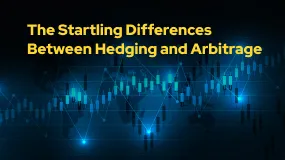简体中文
繁體中文
English
Pусский
日本語
ภาษาไทย
Tiếng Việt
Bahasa Indonesia
Español
हिन्दी
Filippiiniläinen
Français
Deutsch
Português
Türkçe
한국어
العربية
DARTs were 2% lower than in February.
Abstract:Interactive Brokers (Nasdaq: IBKR), a major American electronic trading platform , has released on Friday some monthly operating metrics for March, noting a decrease in the Daily Average Revenue Trades (DARTs).

Interactive Brokers Witnesses a MoM Decrease in DARTs during March
Ending client equity was $355.9 billion for the period.
According to the figures unveiled by the company, it was reported 2.456 million DARTs, which is 18% lower than the prior year and 2% than the prior month. Also, ending client equity was $355.9 billion, representing an 8% higher than 2021 and 2% higher than February.
In terms of ending client margin loan balances, it was $48.2 billion, which is 14% higher than the prior year and 2% lower than the prior month. Ending client credit balances were $92.5 billion, including $2.2 billion in insured bank deposit sweeps than the prior year and 4% higher than the prior month.
Moreover, Interactive Brokers reported 1.81 million client accounts, 36% higher than 2021 and 3% higher than February, as well as 306 annualized average cleared DARTs per client account. Also, the average commission per cleared Commissionable Order was $2.68, including exchange , clearing, and regulatory fees.
IBKR January's Figures
In Januarys metrics, the group company ended with 1.73 million client accounts, which is an increase of 3 percent from the prior month and a 45 percent improvement from the previous year.
Client equity on the platform came in at $352.5 billion, which is 12% higher than the previous year but 6% lower than the previous month. In addition, the client margin loan balance witnessed a 23% yearly increase to $50.1 billion but came in 8% lower than the previous month. Moreover, it ended the month with $89.3 billion in client credit balances, which is 8% higher than the previous year and 3% more than the previous month.
The American broker operates globally in all major markets, offering trading instruments in all popular asset classes.

Disclaimer:
The views in this article only represent the author's personal views, and do not constitute investment advice on this platform. This platform does not guarantee the accuracy, completeness and timeliness of the information in the article, and will not be liable for any loss caused by the use of or reliance on the information in the article.
Read more

The Startling Differences Between Hedging and Arbitrage
The two risk management investment tools - hedging vs arbitrage - have been helping investors achieve their respective financial goals. Explore this comparision to understand their functionalities, the investment purpose they serve, the risk attached, and several other aspects.

Why Octa Is the Ideal Broker for MetaTrader 4 & 5 Users
Octa is a well-reputed, renowned, and award-winning broker in the forex market. It offers many exclusive features to investors, such as educational resources, a wide range of assets, dedicated customer support, and access to popular trading platforms like MetaTrader 4 and 5.

Dubai Police Arrests 4 People in Connection with High and Quick Profits Online Trading Scam
Dubai Police have arrested four individuals involved in defrauding many investors via fake online trading schemes that promised high and quick returns. Check out the arrests, international connections, and more in this story.

Spanish Regulator, CNMV Alerts Investors against 11 Scam Brokers
Spain’s Financial regulator, CNMV (Comisión Nacional del Mercado de Valores) CNMV has issued warnings against 11 forex brokers operating without proper authorization.
WikiFX Broker
Latest News
What WikiFX Found When It Looked Into Vestrado
Is the Forex Bonus a Genuine Perk or Just a Gimmick?
eToro Joins Hands with Premiership Women’s Rugby
OctaFX Was Fined $37,000 for Operating Without a License
Hantec Financial: A Closer Look at Its Licenses
Saxo Bank Fined €1 Million by AMF Over Compliance Failures During IT Migration
CySEC Flags Two Unlicensed Investment Platforms: greymax.net and finotivefunding.com
Hantec Markets Appoints New Executives for Growth in Dubai
Olymptrade Under Fire – Fraud Allegations and Investor Outrage
GoPro, Krispy Kreme join the meme party as Wall Street speculation ramps up
Currency Calculator


